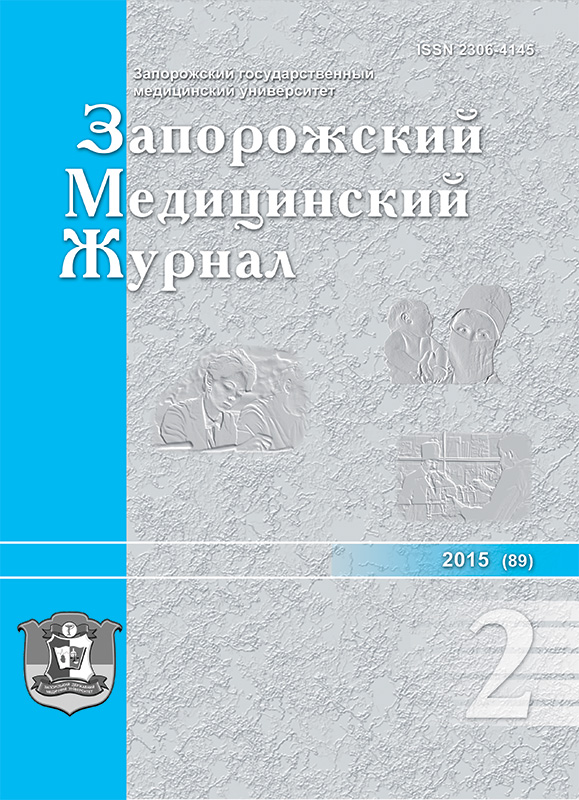Results of sinus trabeculectomy in treatment of patients with combination of glaucoma and cataract
DOI:
https://doi.org/10.14739/2310-1210.2015.2.42111Keywords:
Glaucoma, Cataract, Postoperative Complications, Intraoperative ComplicationsAbstract
Glaucoma is one of the most frequent reasons of vision decline and disability. One of methods of surgical treatment of glaucoma is an operation of filter type – sinus trabeculectomy.
Aim. With the purpose of estimation of operative treatment results of morphological structure of the front part of the eye, hydrodynamics and functional indexes were studied in 49 patients (49 eyes) with glaucoma before and after surgical treatment.
Methods and results. It was established that the operation had high hypotension efficacy. However, reduction of the anterior chamber depth (12,7%), size of the lens increase, resulting in further progression of cataracts and necessity of surgical treatment, were observed after operation. High percentage of intraoperative and postoperative complications, especially in patients with non-ischemic type of glaucoma, were identified after operation.
Conclusion. This data indicates the necessity of changing tactics of treatment of patients with different clinical types of glaucoma regardless of the level of IOP and transparency of the lens.
References
Bezuhlyi, M. B. (2007) Efektyvnist kombinovanoho dvokhetapnoho metodu khiryrhiсhnoho likuvannia pervynnoi vidkrytokutovoi glaukomy (Avtoref. dis…kand. med. nauk). [Efficiency of Combined Two-Staged SurgicalTreatment Method for Primary Open-Angle Glaucoma]. (Extended abstract of candidate’s thesis). Odesa [in Ukrainian].
Zharov, V. V., & Rykov, V. P. (2009). Ciliokhorioidal`naya otslojka (k voprosam etiopatogeneza, profilaktiki i lecheniya) [Ciliochoroid detachment. Literary review] Klinicheskaya oftal`mologiya, 10(1), 40–41 [in Russian].
Zavgorodnyaya, N. G. & Pasechnikova, N. V. (2010) Pervichnaya glaukoma. Novyj vzglyad na staruyu problemu [Primary glaucoma. A new look at an old problem]. Zaporozh'e: Orbita-YuG. [in Ukrainian].
Moshetova, L. K., Cochergin, S. A., Alekseev, I. B., Samoylenko, A. I., & Beisekeeva J. S., (2011). Anatomo-funkcionalnye izmeneniya perednego otrezka posle fakoemul`sifikacii katarakty pri pervichnoj zakrytougol`noj glaukome [Anatomic-functional changes in anterior chamber after phacoemulsification in eyes with primary angle-closure glaucoma]. Glaukoma, 2, 44–51 [in Russian].
Sorokin, E. L., Marchenko, A. N., & Danilov, O. V. (2014). Rol` i klinicheskoe znachenie fakomorficheskogo komponenta v formirovanii pervichnoj zakrytougol`noj glaukomy pri utolshchennoj forme khrustalika (k voprosu o heneze zakrytouholnoi hlaukomy). Soobshchenie 1 [Role and clinical value of phacomorphic component in formation of primary closed-angle glaucoma in case of a thickened lens form (towards a problem of genesis of closed-angle glaucoma)] Report 1. Oftal`mokhirurgiya, 1, 53–59 [in Russian].
Bunce, C., & Wormald, R. (2008) Causes of blind certifications in England and Wales: April 1999–March 2000. Eye. (Lond), 22, 905–911.
De Barros, D. S, Da Silva, R. S, Siam, G. A., Gheith, M. E., Nunes, C. M., Lankaranian, D., et al. (2009) Should an iridectomy be performed routinely as part of trabeculectomy? Two surgeons clinical experience. Eye (Lond), 23, 362–367. doi:10.1038/sj.eye.6703034
Ehnrooth, P., Lehto, I., Puska, P., et al. (2005) Phacoemulsification in trabeculised eyes. Acta Ophthalmol Scand, 83, 561–566.
Herman, D. C., Gordon, M. O., Beiser, J. A., Chylack, L. T., Lamping, K. A., Schein, O. D., et al (2006) Topical ocular hypotensive medication and lens opacification: evidence from the ocular hypertension treatment study. Am J Ophthalmol, 142, 800–810. doi: 10.1016/j.ajo.2006.06.052.
Hitchings, R. A. (2009) Glaucoma: an area of darkness. Eye. (Lond), 23, 1764–1774. doi: 10.1038/eye.2008.260.
Keenan, T. D., Salmon, J. F., Yeates, D., & Goldacre, M. J. (2009) Trends in rates of trabeculectomy in England. Eye. (Lond), 23, 1141–1149. doi: 10.1038/eye.2008.195.
Lu, D. (2009) Trabeculectomy in patients with primary angle-closure glaucoma. WGA abstracts, 269.
Musch, D. C., Gillespie, B. W., Niziol, L. M., Janz, N. K., Wren, P. A., Rockwood, E.J., et al. (2006) Cataract extraction in the collaborative initial glaucoma treatment study: incidence, risk factors, and the effect of cataract progression and extraction on clinical and quality-of-life outcomes. Arch Ophthalmol, 124, 1694–1700. doi:10.1001/archopht.124.12.1694.
Marthew, R. G., & Murdoch I. E. (2011) Тhe silent enemy: a review of cataract in relation to glaucoma and trabelculectomy sugery. Br J.Ophtalmol., 95(10), 1350–1354. doi: 10.1136/bjo.2010.194811
Varma, R., Richter, G., Torres, M., Foong, A. W., Choudhury, F., & Azen, S. P. (2010) Four-year incidence and progression of lens opacities: The Los Angeles Latino Eye Study. Am J Ophthalmol, 149, 728–734. doi: 10.1016/j.ajo.2009.11.012.
Rajavi Z., Moezzi-Ghadim, H., & Kamrav, K. (2009) The Effect of Trabeculectomy on Cataract Formation or Progression. J Ophthalmic and vision research, 4(2), 84–89.
Zhang X., Teng, L., Li, A., Du, S., Zhu, Y., & Ge, J. (2007) The clinical outcomes of three surgical managements on primary angle-closure glaucoma. Yan Ke Xue Bao., 23(2), 65–74.
Downloads
How to Cite
Issue
Section
License
Authors who publish with this journal agree to the following terms:
Authors retain copyright and grant the journal right of first publication with the work simultaneously licensed under a Creative Commons Attribution License that allows others to share the work with an acknowledgement of the work's authorship and initial publication in this journal. 

